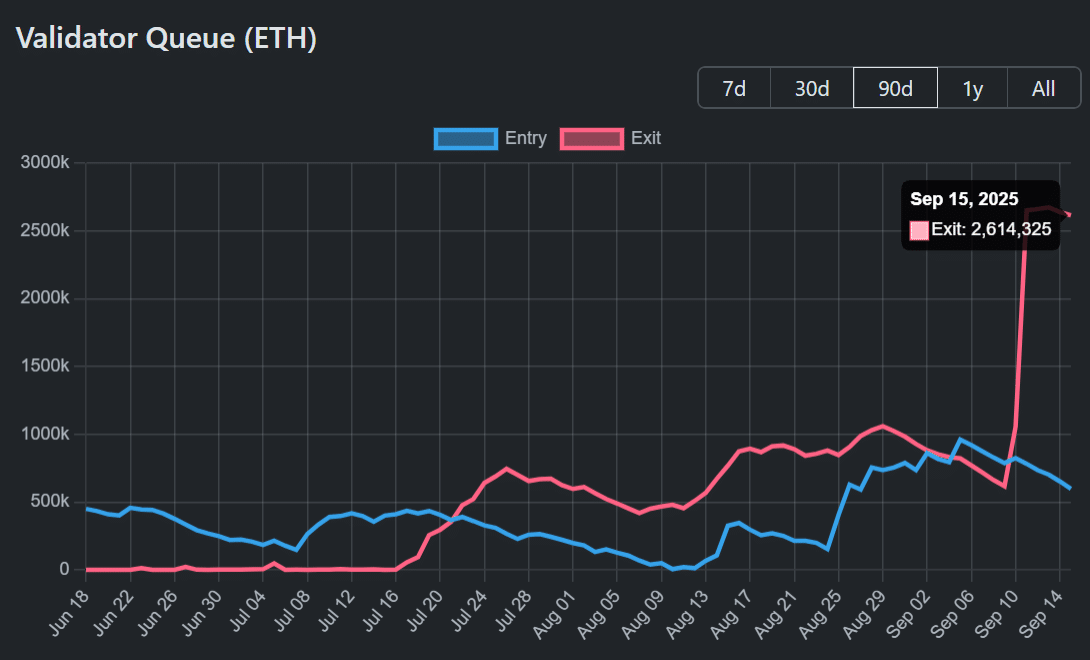Ethereum’s Total Value Staked (TVS) fell ~150k ETH this week as a validator exit queue surge—largely driven by Kiln withdrawing 1.6M ETH after the SwissBorg incident—prompting short-term rotation into higher-yield DeFi as staking APR dropped below 3%.
-
Exit queue spike largely rotational, not a sell-off
-
Kiln’s 1.6M ETH pull explains ~61% of the current exit queue.
-
Staking APR fell to 2.84%, pushing capital into DeFi pools with higher returns.
Ethereum TVS drop explained: 150k ETH exit due to validator reshuffle and Kiln withdrawals — learn implications and next steps for stakers.
What caused Ethereum’s TVS to drop by ~150k ETH this week?
Ethereum TVS dropped by roughly 150k ETH primarily because the validator exit queue surged to 2.63M ETH and large institutional withdrawals—most notably Kiln’s 1.6M ETH—temporarily removed stake from the network, while lower staking APRs encouraged DeFi redeployment.
How big was the exit vs entry queue change?
Exit queue rose to 2.63 million ETH (~$12.3B) with a ~45-day wait, up from 616k ETH last week. The entry queue fell to 597k ETH (~$3B), signaling net exit pressure and a short-term TVS contraction.
| Metric | Prior Week | Current | Change |
|---|---|---|---|
| Exit queue | 616,000 ETH | 2,630,000 ETH | +327% |
| Entry queue | 823,000 ETH | 597,000 ETH | -27% |
| Staking APR | ~3.2% | 2.84% | -0.36 pp |
Why did Kiln’s actions matter?
Kiln, a professional ETH staking provider, removed ~1.6 million ETH from validator nodes following the SwissBorg hack fallout. That single move represents approximately 61% of the current exit queue, making the spike largely a concentrated institutional reshuffle rather than broad retail capitulation.

Context: While the exit queue number appears alarming, concentration in a few large operators means the network’s long-term staking fundamentals remain intact.
How is DeFi absorbing the outflow?
With staking yields compressing to 2.84% APR, institutional and retail capital is redeploying into DeFi strategies offering higher returns. Example: Pendle stETH pools are advertising ~5.4% APR, attracting a sizable portion of newly unlocked ETH.
Market data shows Ethereum’s TVL rising to near four-year highs (~$97B) as liquidity rotates into DeFi protocols, signaling reinvestment rather than outright liquidation.

What does this mean for stakers and validators?
Short-term: validators face compressed yields and longer queues; some operators will temporarily exit or redeploy. Long-term: network security remains supported, but yield-sensitive capital may continue cycling into higher APR DeFi products until staking rewards recover.
Frequently Asked Questions
Will the TVS drop meaningfully weaken Ethereum’s PoS security?
No. The TVS decline is driven mainly by a concentrated operator withdrawal and rotational flows to DeFi. Network security metrics remain robust; a temporary TVS dip does not equal a systemic security failure.
How long will the exit queue delay affect withdrawals?
The exit queue shows ~45 days wait for current levels. Delays depend on queue size and validator churn; if large operators redeploy off-chain or split exits, waits can shorten over subsequent epochs.
Key Takeaways
- Exit queue surge was concentrated: Kiln’s 1.6M ETH explains most of the spike, making it rotational.
- Staking yields compressed: APR fell to 2.84%, prompting capital rotation into DeFi.
- Short-term TVS fall ≠ network failure: Security remains supported while liquidity shifts to higher-yield protocols.
Conclusion
The recent ~150k ETH TVS decline reflects a validator reshuffle and yield-driven rotation, not a wholesale loss of conviction. Monitor exit queue trends, staking APR, and DeFi inflows for signals on whether this rotation stabilizes or persists. For ongoing coverage, COINOTAG will update this story as data evolves.
Published: 2025-09-15 · Updated: 2025-09-15 · Author: COINOTAG





